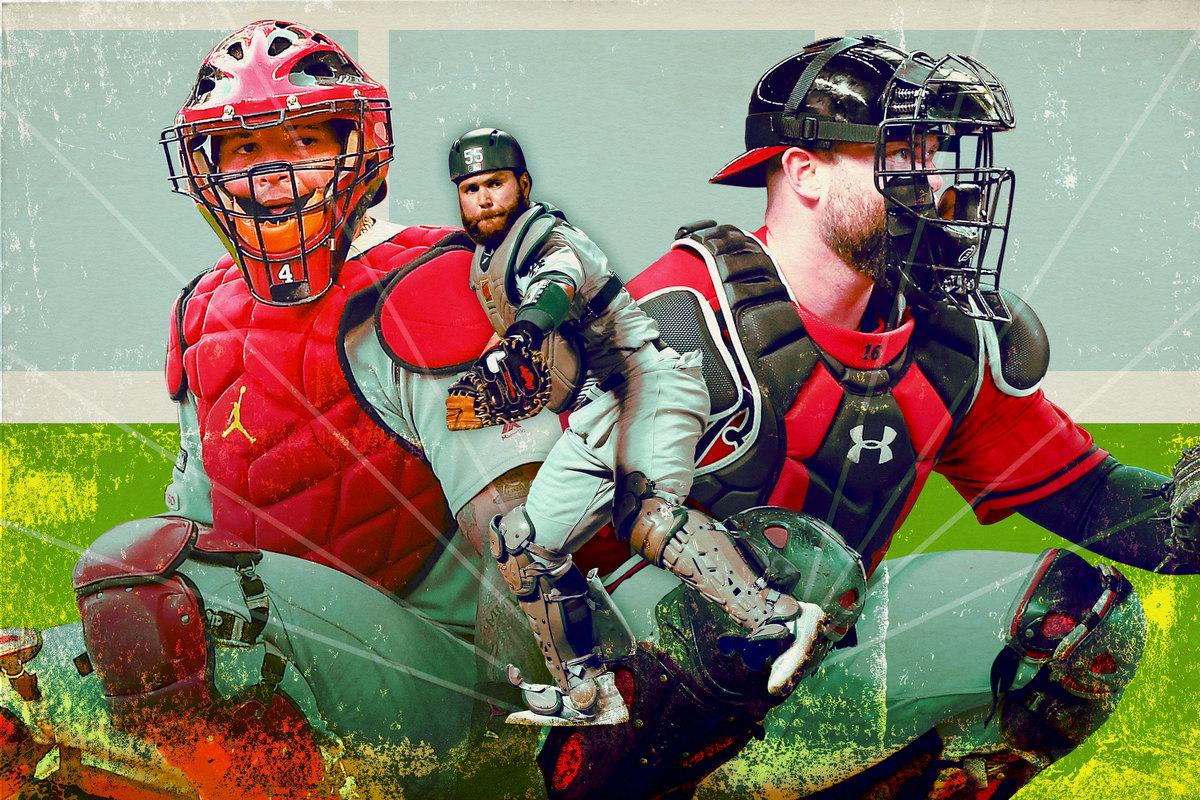
On Wednesday, four National League teams will face off in the fifth and final games of the NLDS. Those combatants have something in common beyond being one win away from the NLCS and one loss away from elimination: They all employ old catchers. Along with the Astros’ Robinson Chirinos, who’s also still appearing in the postseason, this quartet of catchers of a certain age—the Cardinals’ Yadier Molina (37), the Braves’ Brian McCann (35), the Nationals’ Kurt Suzuki (36), and the Dodgers’ Russell Martin (36)—led the majors this season in FanGraphs WAR generated by catchers 35 or older.
In terms of career accomplishments, one of these receivers is not like the others. So with all due respect to his late-career renaissance, let’s set Suzuki aside, as opposing pitchers have set him aside in his 0-for-11 start to October. The other three catchers form a decorated group with 28 trips to the postseason, 20 All-Star selections, 10 Gold Glove awards, and eight Silver Slugger awards between them. Each member of the trio has played a pivotal role in propelling his team to Game 5. Molina drove in both the tying and winning runs in Game 4. In Martin’s lone playoff appearance so far, in Game 3, he lined a go-ahead double that championship win probability added ranked as the biggest hit in the series’ first four games, and later added a two-run homer. McCann is 2-for-13 with no runs driven in, but he did enable big hits: In Game 2, his seventh-inning single set up Adam Duvall’s pinch-hit, two-run homer, and in Game 3, his fateful ninth-inning intentional walk passed the baton to Dansby Swanson and put the winning run on base (although McCann, who was lifted for pinch runner Rafael Ortega, wouldn’t be the one to cross the plate).
On the last day of the year all three of these catchers’ clubs will be in action—and the day we find out which one or two will survive to see the NLCS—let’s try to answer a complicated question. Imagine I’m showing you head shots of Molina, McCann, and Martin. How many Hall of Famers am I holding up?
The most common answer would probably be one: Molina. Molina has nine of those All-Star selections and nine of those Gold Gloves, and he twice finished in the top four in NL MVP voting. He’s beloved or respected by fans, teammates, and media members, he’s played for four pennant winners, and he’s a two-time (and counting) World Series winner. He already owns the record for most games caught with one team, and if he stays healthy next season—his last under his current contract, although maybe not his last overall, as he once indicated it would be—he’ll climb to fourth on the all-time games caught leaderboard. (If we count playoff games, he already ranks fifth.) He’s a whiz at the more obvious aspects of defense—throwing out runners, discouraging steal attempts, blocking balls—and he’s reputed to be brilliant at the more subtle and sabermetrically opaque (pitch-calling, working with pitchers, clubhouse chemistry, and defensive positioning). Although offense isn’t his strong suit, he’s hit .300 five times.
The next most common answer would probably be zero. Although Molina has hit for high averages, he hasn’t walked often and hasn’t typically produced much power, so his career offensive stats are slightly below league average. Consequently, his Cooperstown case rests partly on intangibles. As longtime teammate Matt Carpenter said this week, “When his career’s over, said and done, you’ve got to look past just the standard baseball-card numbers and realize just how many winning teams he was on, and how big of a role he played in some of those postseason moments.” That’s not necessarily spurious reasoning: In Molina’s case, talents we can’t currently quantify may have made him much more valuable. But not every voter will take his teammates’ words for it, and most fans outside of St. Louis won’t have seen those supposed skills for themselves.
The least common answer would probably be three: Put them all in. Yet that might be the most sensible response.
If you think that sounds implausible, there are plenty of stats that support you. Other stats say you’re wrong. Yes, advanced value measurements are conflicted on this topic too. The table below lists Molina’s, McCann’s, and Martin’s all-time ranks among catchers in career Baseball-Reference WAR, FanGraphs WAR, and Baseball Prospectus WARP (which, unlike the others, goes back only to 1921).
Career Ranks Among Catchers by WAR(P)
When we’re assessing a catcher’s Cooperstown credentials, the gap between the range in the second column (all-time top 25-35) and the range in the third and fourth columns (all-time top 10-15) is all important. There are only 18 catchers in the Hall of Fame (and 15 non-Negro Leaguers) for the fewest inductees at any position other than third base, so the difference between Molina’s, McCann’s, and Martin’s ranks at B-Ref and their ranks at FanGraphs and BP means the difference between being better than many already enshrined catchers and being worse than almost all of them.
According to B-Ref WAR, Molina is the best of the three, but none of them meets the Hall’s established standards. FanGraphs and BP, by contrast, suggest that Molina is the worst of the three but that all of them are Cooperstown-caliber. So why are Molina, McCann, and Martin worth between 14 and 23 wins more—a difference of between 35 percent and 71 percent of their overall career value—via one WAR than the other?
The discrepancy comes down almost entirely to one attribute: pitch-framing, or the ability to receive and present pitches in a way that makes them more likely to be called strikes. Unlike Suzuki, Molina, McCann, and Martin have historically excelled in that area, and to varying extents, they still do. Here’s Molina pissing off Swanson in NLDS Game 2 by getting a call on a pitch that Pitch Info assessed as only 1.3 percent likely to be called a strike, based on the location, count, pitch type, and batter and pitcher handedness:
Here’s McCann in Game 3, getting a strike on an equally frustrated Marcell Ozuna that Pitch Info estimates would be called the way it was only 2.1 percent of the time:
And here’s Martin in Game 3, victimizing the precocious, plate-disciplined Juan Soto on a pitch that was only 30.4 percent likely to be called a strike:
Granted, any one of those favorable calls could have been a fluke or an umpire error that had little to do with how the catcher presented the pitch. But when the same catchers consistently get calls across thousands of opportunities, the evidence starts to stack up that those guys are good. McCann, Martin, and Molina have been among the best during the pitch-tracking era, and when FanGraphs incorporated framing into WAR in March, they were the three biggest beneficiaries, on the order of 15-20 WAR.
Molina and McCann, at least, may make it to the ballot sporting shiny old-school stats: 2,000 hits, in Molina’s case, and 300 homers in McCann’s. That’s not nothing, considering catchers’ lower offensive standards. But Martin is a career .248 batter and .397 slugger, and neither he nor McCann ever finished higher than 13th in MVP voting. Now I’m trying to tell you that they might deserve a spot in Cooperstown based on metrics that didn’t exist when their careers began. You may have some questions. Let’s take them one at a time.
Can we actually measure framing, and does it really matter that much?
Yes. Public and private analysts have been studying framing for more than a decade with the aid of pitch-tracking technology, which was installed in all MLB parks by 2008. Numerous independent studies have detected differences of up to several wins per season between the best and worst framing catchers and teams, which makes framing by far the most important part of catcher defense as we understand it today. These differences are observable in small samples and persist across seasons, so we know they aren’t just random. And while “framing runs” may sound somewhat abstract, framing performance is reflected in the surface stats we’re used to seeing. Pitchers who work with skilled framers yield fewer walks, record more strikeouts, and allow fewer runs than they do when working with less adept batterymates. Pitchers who work with poor framers suffer the opposite fate.
Fine, we can quantify it and it’s worth a lot, but isn’t it cheating?
Short answer: no. Not technically, at least. Nothing in the MLB rule book dictates how a catcher is or isn’t supposed to receive a pitch, except to say that he has to catch it in his mitt and he has to stay in the catcher’s box until the pitcher releases the ball. After that, any movements he makes are fair game.
Of course, a strike is supposed to have passed through the strike zone, and the strike zone is strictly defined horizontally and at least loosely defined vertically. As you may have noticed from time to time, though, some strikes do not pass through the strike zone, and umpires aren’t tossed for breaking the rules whenever they incorrectly call one. That’s because baseball’s ball and strike calls rest on an often frustrating foundation of umpire infallibility. The MLB rule book makes clear that the buck stops with Blue, declaring, “A strike is a legal pitch when so called by the umpire.” Ultimately, a pitch is a strike if an umpire says it’s a strike, which is why team personnel aren’t allowed to dispute umpire’s ball/strike rulings, just as kids can’t overrule their parents’ argument-ending “Because I said so.” But as long as the umpire’s calls can be influenced before the fact, catchers can legally add value by nudging umps toward decisions that benefit their teams.
OK, but isn’t it still unsportsmanlike? You just called it “stealing strikes”! Why should we reward stealing or credit catchers for an umpire’s incompetence?
Well, for one, we always have. Not through WAR, but through other incentives: strike calls, compliments, salary, and playing time. Framing has been part of baseball for far longer than the Hall of Fame—since at least the dead-ball era, and probably before. In his 1914 manual How to Play Baseball, catcher and future Hall of Fame manager John McGraw provided instructions for “shaping the ball,” or funneling it toward the strike zone and presenting it cleanly and quietly so as to earn extra strikes. References to framing also abound in books from the ’50s and later. The difference today is that we can quantify framing, and because we know how much it matters, everyone wants it. Teams are paying for framing in free agency (as McCann and Martin found out). They’re also trying to teach players to frame better, and some players are schooling themselves.
“Because it’s always worked this way” isn’t in itself a strong selling point. But as long as umpires are calling pitches, and as long as it’s possible for catchers to use their receiving skills to expand the zone, it seems inconsistent not to account for that contribution the way we account for fielding bunts or throwing out runners. We reward robbing homers, so why not stealing strikes? In both cases, a glove gets in the way of a potentially harmful event and turns it into a triumph.
You don’t have to be happy that framing is real. You can lobby for framing to be abolished. But for the purposes of this discussion, whether catchers should be able to affect calls is almost irrelevant. For now, they do affect calls. Strikes lead to outs, and outs add up. WAR lets us know what that’s worth.
But framing data doesn’t cover the whole history of the game. Isn’t it unfair to judge today’s players by different criteria than we use to judge past players?
Yes, sort of. FanGraphs provides framing values going back to 2008. BP takes them further by extending the framing era to 1988, the first year for which we have near-complete records of pitch-by-pitch outcomes. Because we lacked precise pitch locations until 2008, those first few decades of framing runs are estimates based on rates of called balls and strikes, so their magnitudes tend to be smaller. Other methods can quantify catchers’ work behind the plate for even earlier years, with even more uncertainty in small samples.
It is unfair for players from earlier eras that our newest, fanciest stats don’t work as well retroactively, but it’s also unavoidable (and it helps as many past players as it hurts). We’ll never have exit speeds or spin rates for players from before 2015, but we still track them today. We know much more about all aspects of fielding today than we did before MLB and third-party providers began to track batted-ball locations and characteristics and fielder positioning, and we haven’t chosen to limit ourselves to our old, imprecise stats. We’ve applied our souped-up defensive data to as many seasons as we can, and we’ve done what we can to enhance the old data. (Baseball-Reference rejiggered catcher defense for players prior to 1953 just this spring.)
We can do the same for framing, as long as we use the stats responsibly. For instance, we can’t say with confidence that McCann should really rank right between Gary Carter and Yogi Berra in career value, as he does on BP’s leaderboard. We know he was worth roughly as much with framing as they were without, but we don’t have framing data for Yogi, and the few years we do have for late-career Carter indicate that his prime was probably better than his WARP would suggest. One solution is to give Molina, McCann, and Martin partial credit for framing, which would make them borderline candidates rather than slam-dunk ones. If we judge them just against their contemporaries, though, we see that they’re still the top three catchers in framing runs from 2008-19, a period during which they trail only Buster Posey in catcher WAR. (From 2008-14, they were among the 5-10 most valuable position players, period.) Even if they’re only the best from their own era, not every era, that still might merit a call from the Hall.
But wait, what about robot umps?
It’s possible that by the time Molina, McCann, and Martin hit the Hall of Fame ballot five years after they retire, MLB will be using a computer-assisted strike zone system like the one that was tested in the Atlantic League this summer. Opinions vary widely on whether that would be good for bad for baseball and whether the technology will be up to the task, but we know this much: Robo umps would spell the end for framing. Strikes would be strikes because the computer said so, and computers aren’t so suggestible.
It’s already harder for catchers to accrue receiving runs than it was a decade ago, because the league’s increased focus on framing has narrowed the divide between backstops. If framing is endangered or extinct by the time Molina, McCann, and Martin are eligible for induction, voters may not be inclined to give them credit for a passé skill. In their own era, though, a great framer was worth a fortune, and that value can’t be wiped away.
For now, this is just a thought exercise (although the threat of stolen strikes in the postseason is very real). However, I’ll have a Hall of Fame vote beginning with the class of 2022, so sometime next decade, I’ll have to decide whether to tick the boxes by the names Molina, McCann, and Martin. By then, WAR will be even more mainstream. The stat is always evolving, and it’s almost certain that someday soon, all versions of WAR(P) will factor in framing. (B-Ref, the lone holdout, already reports pitch-calling and framing runs on its pages, but those values are still excluded from the WAR formula.) If all of those metrics tell the same story, the numbers will be tough to ignore.
Are Molina, McCann, and Martin Hall of Famers? That’s a sticky question for the future to solve. But as you watch Wednesday’s games, remember that you’re witnessing a specific sort of greatness, whether or not it ever earns a player a plaque.

